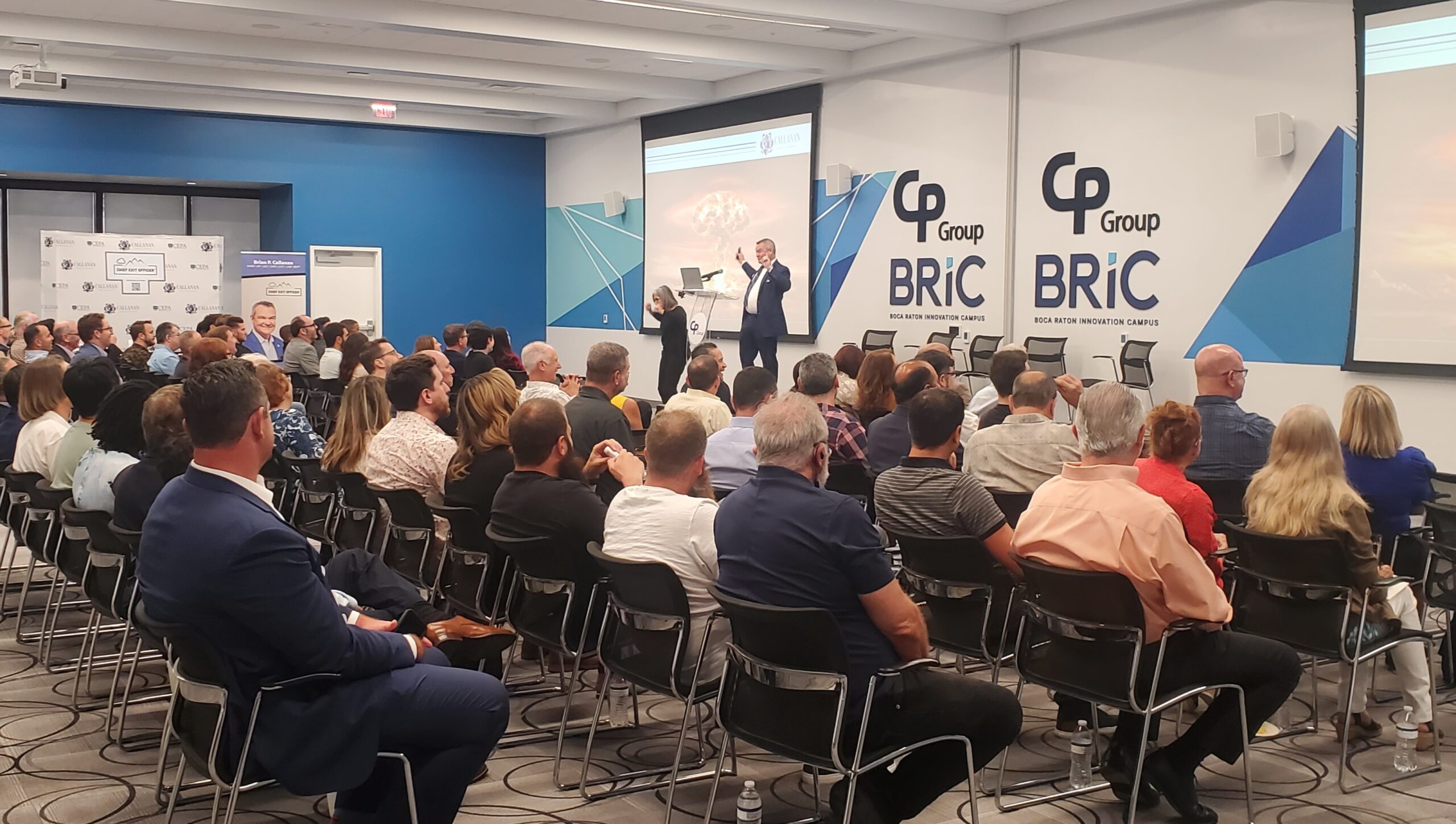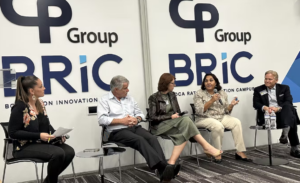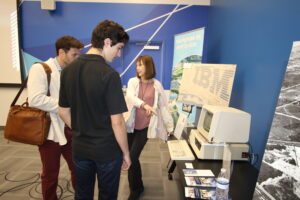From Miami Beach to Palm Beach, South Florida is becoming one of the best-known tech hub’s across the country.
Many cities throughout the state of Florida — now the fastest-growing state in the nation — have been announced as up-and-coming tech hubs. South Florida Tech Hub recently celebrated the birth of the tech scene in South Florida and our region’s continued innovation at the “History & Future of Tech in South Florida” event held at the Boca Raton Innovation Campus.
Guests at the event enjoyed a blast from the past as we explored the era of IBM’s first PC, the ground-breaking research being done, and the thousands of patents and inventions still driving technology today. We heard from some of the original OGs of South Florida tech and former IBM employees – where they went, what they built, and where they are now.
ABOUT THE VENUE
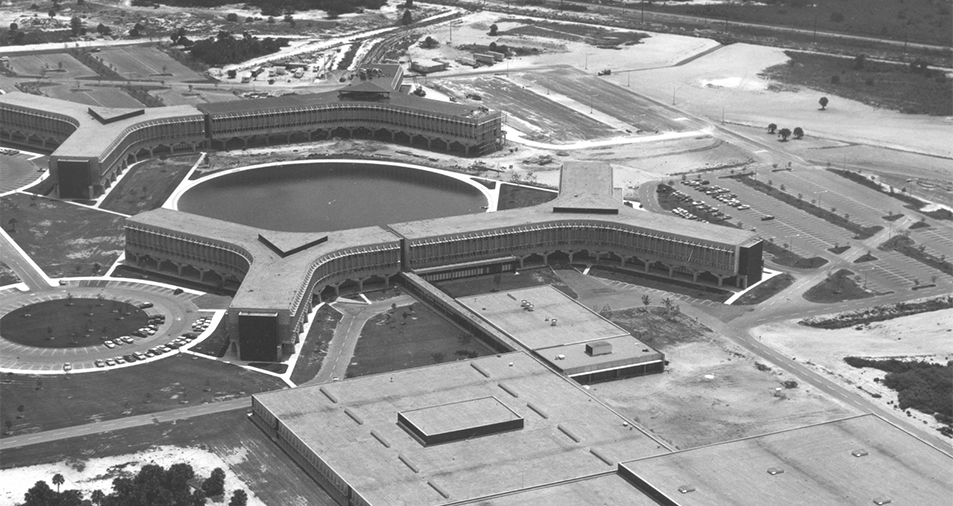
Aerial view of BRIC, formerly the IBM complex from 1971 – 1973.
South Florida holds a major piece of tech history right in the heart of Boca Raton. Designed by iconic architect Marcel Breuer, the Boca Raton Innovation Campus, or “BRIC,” was IBM’s North American Research and Development facility in the 1960s.
BRIC is home to the invention of the first personal computer. IBM’s own PC (IBM 5150) was introduced in August 1981, only a year after corporate executives gave the go-ahead to Bill Lowe, the lab director in the company’s Boca Raton facilities. He set up a task force that developed the proposal for the first IBM PC.
As home to the invention of their first personal computer, one might argue that the future of tech in South Florida began here!
The office park has been significantly upgraded since Crocker Partners acquired the property in 2018.What began as an outpost for IBM’s R&D and became the birthplace of the PC is now a state-of-the-art office park that is a magnet for forward thinkers in technology and life sciences. There is a growing roster of entrepreneurs, visionaries and global enterprises who have chosen BRIC as their stomping grounds.
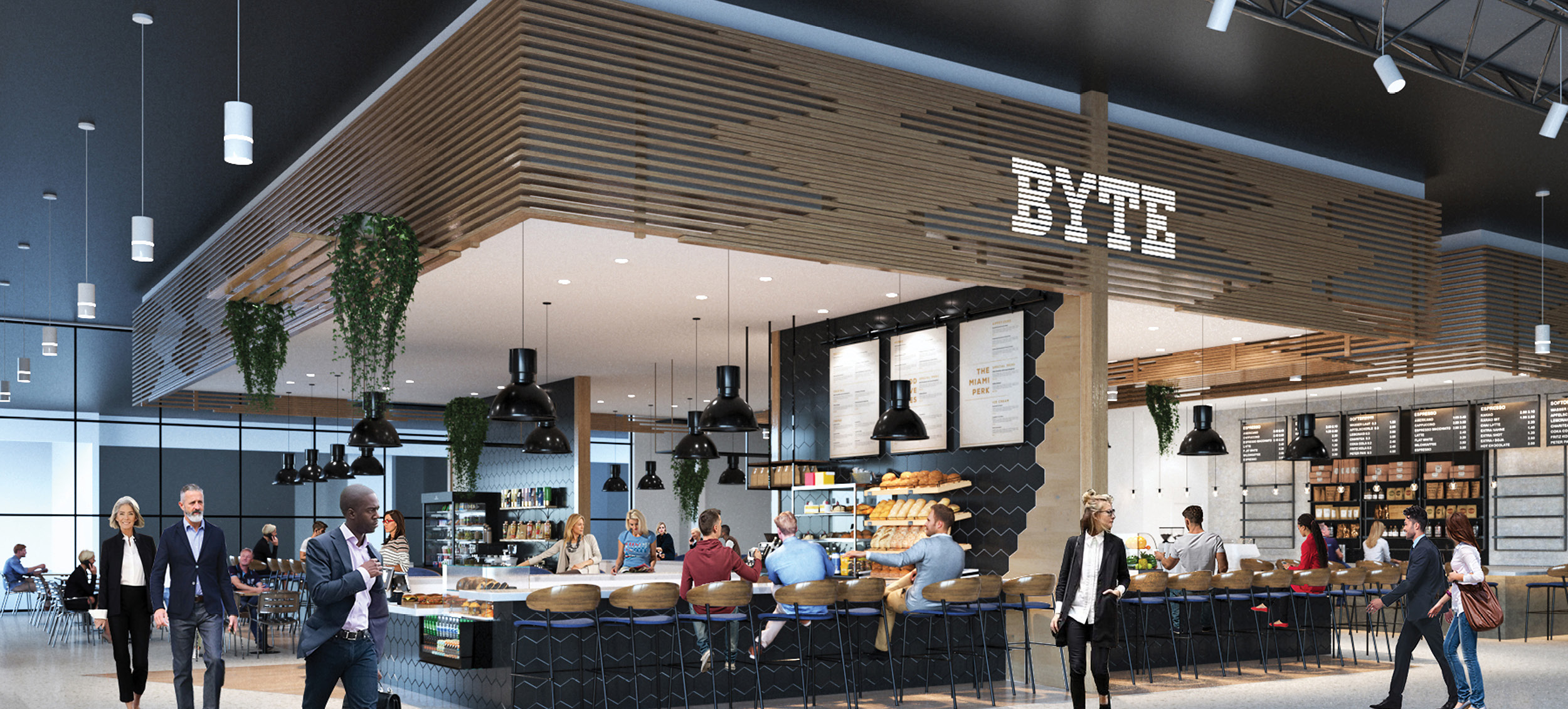
conceptual rendering
Today, at 1.7 million square feet, BRIC is the largest single-office facility in the state of Florida. BRiC consists of three interconnected facilities located on 123-acres of beautifully maintained land with a lake situated in the center of the property, offering supreme office views and walking paths. CP Group, formerly known as Crocker Partners, has a massive vision of building off its innovative past and evolving the campus into the premier technology and life sciences hub in the Southeast.
Among the future featured amenities, there will be a Science Technology Engineering Art and Technology (STEAM) lab and coworking space, presentation hall that seats up to 1,000 to host science and technology trade shows, TedX events, coding camps and community events, a wellness center, including on-site salon, medical center and massage therapy and so much more. The renovations and construction have already begun.
Oh, and BRIC is also home to the longest hallway in America coming in at 907 feet. For comparison, the Statue of Liberty is 305 feet tall, the Gateway Arch is 630 feet and the Golden Gate Bridge stands at 746 feet in height.
ABOUT THE KEYNOTE
Dr. Dave Bradley
The event started with a special keynote by Dr. Dave Bradley, or “Dr. Dave,” one of the twelve engineers who worked on the original IBM PC. He is famously known for developing the computer’s ROM BIOS code and for implementing the “Control-Alt-Delete” key combination used to reboot the computer. In his speech, he shared insights on early IBM marketing, the release of the first personal computer, working with Bill Gates, and other significant inventions.
Although internationally know for being the inventor of CTRL-ALT-DELETE, he doesn’t think this is his biggest contribution to to computing history. He’s proud that he created something became so popular, but knows that this is minimal to some of the other development work having been done in IBMs early days.

Bradley described the time that he helped with a sales pitch to the Rose Hulman Institute of Technology, aiming to convince them to use personal computers as part of their instruction. They showed a demo program allowing the user to pick a song, which is then played on the two-and-a-quarter-inch speaker. However, there were 30 people in the room. They came up with the idea to plug in a guitar amplifier into the cassette cord. Then, no matter what song the user chooses, The Stars and Stripes Forever is played. They made the sale.
During testing of the IBM PC, Bradley frequently had to power the computer off, wait a few seconds, and turn it back on. As a result, he decided to make a shortcut: CTRL + ALT + DELETE. This was never supposed to be used in production, but then the publications team found out about it. They were trying to tell people how to start up a program, and they found the answer with the keyboard shortcut. It took Bradley five minutes to create and has since become an essential element of the user experience and even a “cultural icon”.
After the success of the IBM PC, thousands of IBM employees started working on the PS/2 family of products in Boca Raton. They took up so much office space, and even expanded into the Boca Raton mall where a department store went out of business. Bradley remarked that IBM filled all of Boca Raton in order to get the PC developed.
PANEL DISCUSSIONS
 The evening’s agenda featured two panel discussions focused on the history and future of South Florida’s tech ecosystem and featured some of the trailblazers of modern technology.
The evening’s agenda featured two panel discussions focused on the history and future of South Florida’s tech ecosystem and featured some of the trailblazers of modern technology.
The goal of the event was to educate the community about South Florida’s history in tech and innovation, honor some of the former IBMers who made huge strides back in the 80s, 90s and 2000s allowing the rest of the tech community to flourish today, and showcase what many of these technology leaders are doing currently.
Many people have no idea the original IBM PC was even born in South Florida, the fact that the company has thousands of patents that a huge percentage of current tech companies use, or that these tech professionals didn’t just stop innovating after they left IBM.
IBM patents range from the ATM to e-commerce, speech recognition technology, two-nanometer chips, the UPC bar code, Lasik laser eye surgery technology, screen rotation technology, “siesta” or sleep mode on the computer screen (Pete Martinez), quantum computing and so much more!
Now, the future of IBM is cloud, AI and quantum computing.
PANEL: History of Tech
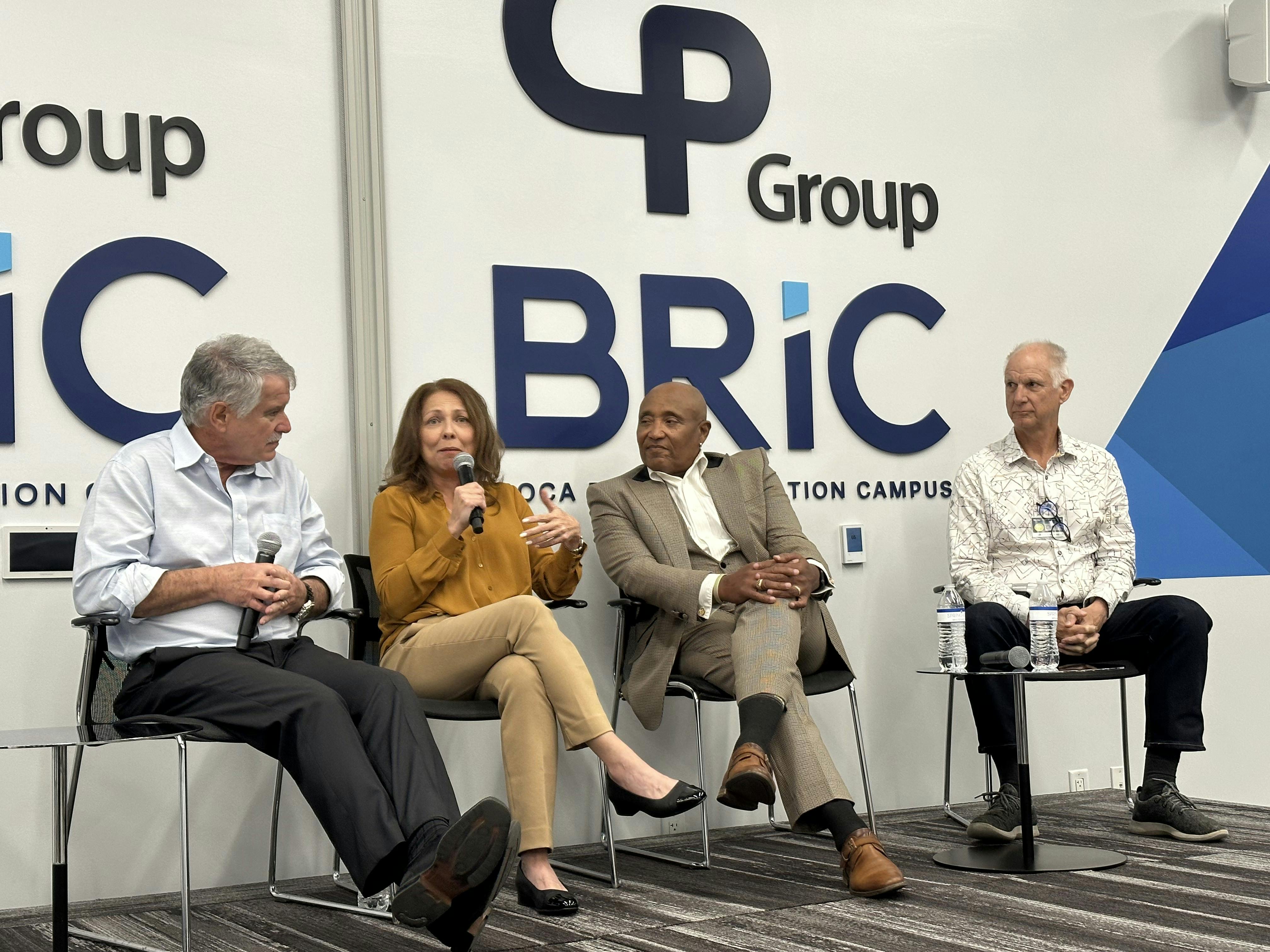
history of tech panel
The history of technology panel discussion was moderated by Pete Martinez, former IBM executive and founder of Sivotec and RaiseLink. Panelists included Chris Fleck, a former IBM executive and Vice President and Tech Fellow at Citrix, Maria Hernandez, a former Chief Innovation Officer-LATAM at IBM and CEO of InnoGuia, and Nick Savage, a former Senior NLS Developer at IBM, entrepreneur, and Digital Inclusion Director at CPSF. Each speaker transformed from working at IBM to executive roles or founding their own companies.
Each former IBM employee shared stories of their experiences at IBM, the culture around innovation they created, and some of the forward-thinking projects they were a part of at the time.
- Hernandez was a developer on IBM’s airline reservation system in 1985, which, believe it or not, is still in use as a main system today. She also served as the technical assistant to the senior vice president of research. Her job was to help take research projects to the market faster. Hernandez helped train the voice control in cars’ natural language processing algorithm. She worked with Modernizing Medicine to introduce IBM Watson and AI to the healthcare industry.
- Savage was a Senior Systems Engineer & Product Manager helping to develop the disk operating system (DOS) and modernize the keyboard into a software app. Savage remarked that he knew he was at the forefront of something great. He helped design SQL (Structured Query Language), and all the products building off of the operating system. Savage was in biweekly meetings with Bill Gates, Steven Ballmer, and Paul Allen. Savage was asked to escort the IBM Personal Computer AT to its announcement in New York. The AT computers took up three first-class seats.
- Fleck was a Business Unit Executive at IBM, working on mainframe manufacturing. Fleck turned a lot of IBM technology into commercial offerings, such as IBM branded robots and industrial computers.
- Martinez described his department in IBM working long hours on the original PCs and being given special permission from IBM to break the rules, to not conform to the old standard of five years of product development and three years of testing. They became a favorite of the company, which came with respect, but also responsibility. Failure was not an option. Martinez used the RISC chip (reduced instruction set computing), which was very fast, allowing a PC to act like a supercomputer. He and his team worked with the Center for Missing and Exploited Children to do the age progression of children who had been missing for years. This process would take around two weeks for a skilled agent to do manually, but the IBM team reduced this to about an hour. This led to an increase from a 46% to a 78% recovery rate in a year.
PANEL: Future of Tech
The future of technology panel was moderated by Nikki Cabus, CEO of South Florida Tech Hub. Panelists included Pete Martinez (above) , Vanessa Michelini, a former Distinguished Engineer and Chief Technologist at IBM and Senior Director of Engineering at Natera, Mark Smith, a former VP and Senior Partner at IBM and President of OZ Digital Consulting, and Ania Rodriguez, a former UX Consultant at IBM and CEO of JourneyTrack.
Panelists discussed the biggest contributions of South Florida’s tech industry, the largest enterprises, the coolest startups, and companies that made an impact in the industry.
- After working at IBM, Martinez decided to dedicate his next stage in life to improving the human condition, primarily in health and education. He created a number of companies, primarily in the AI space, starting with biotech and genomics. Martinez also co-founded a fintech company called RaiseLink, which uses a matching engine to link investors with startup opportunities, supported by AI technology.
- Michelini worked on applying speech recognition technology to the industry at IBM before moving on to the genomics space. She worked on a project called Watson Genomics, which focused on using artificial intelligence and data analytics to interpret genomics in clinical oncology. Michelini fell in love with the mission of helping people through the combination of biology and technology. She joined Natera, a company dedicated to using genomics to interpret oncology, prenatal care, and organ transplants, after leaving IBM.
- Rodriguez started at IBM in 2000, where she worked on building user experience and front-end interfaces, which she excelled at, particularly in accounts that were struggling with their technology. She also mentioned being part of a program for top ten women at IBM, which allowed her to meet many influential people. Rodriguez started her own consulting firm, which ended up being one of South Florida’s top women-led businesses. Rodriguez’s firm works with Fortune 500 companies to help optimize their digital transformations by focusing on the strategy behind it, rather than the design. Rodriguez also shared her recent successful venture into SaaS (Software as a service) product creation. However, she has had some difficulties with fundraising, particularly as a woman in the industry.
- Smith worked in the management consulting group at IBM and focused on digital transformation, using artificial intelligence. He also worked on commercializing Watson’s natural language processing capabilities to help clients digitize unstructured data in the insurance industry. The main struggle was to attain trust in the data and algorithm. Now with OZ Digital Consulting (the food sponsor of the evening!), Smith works with startups to help them leverage emerging technologies and solve business gaps. Smith believes that startups are often at the forefront of innovation and offer valuable insights on how to use emerging technologies.
For almost 30 years, IBM led the United States in producing patents and in its pinnacle year filing over 10,000 US patent applications just that year. That’s more than any other tech company including companies like Google, Apple and Microsoft. These patents generate around $3 billion per year. They do not need to build products anymore, instead, they license them. Therefore, IBM technology is used extensively behind the scenes.
That all changed in 2022 – the first time since 1993 that IBM didn’t claim the top spot on the list of companies with the most U.S. patents. That was completely intentional though. IBM decided that they no longer aimed to be the leader in patent creation, but in innovations in hybrid cloud, artificial intelligence and quantum computing. IBM has been opening collaborating with competitors in an effort to further innovation. IBM has re-focused.
OUR EVENT PARTNERS
The Boca Raton Historical Society Martinez made a patent called siesta mode, which turns off the monitor when it is not used for a period of time. exhibited a working original IBM personal computer at the event which was a treat for our younger attendees who probably hadn’t seen one in real life. It sure captured some of their attention.
Brian Callanan from Callanan Financial Advisors opened with a sponsor message telling his story of “1995’s spring break capitol of the world” in Ft. Lauderdale as a college student to relocating back to South Florida years later during a time when the internet and technology industry was rapidly evolving, with companies like Microsoft, Craigslist, Match.com, Amazon, and eBay emerging as major players. Only 12 million people, or 3% of Americans, had logged onto the World Wide Web at that time.
Callanan initially sold telephone systems, voicemail, and data networks before getting involved in the technology community. He was introduced to an organization by a direct competitor and began attending meetings with a small group of like-minded individuals to stay on top of the latest developments. As the group grew in size and influence, Callanan became increasingly involved in regional technology initiatives, eventually serving as president of the South Florida Telecom Forum which was later acquired by SFTA and then by South Florida Tech Hub.
Callanan shared some insights on the current market trends for platform acquisitions. Private equity firms are the main financiers in this space and are actively seeking businesses in the tech and skilled labor sectors. Callanan emphasized the importance of having scalable, bankable profits and transferable value for companies to be considered exit-ready. He also mentioned the importance of effective communication among professionals to avoid costly mistakes. In addition, Callanan encouraged a regional approach to promoting South Florida’s tech ecosystem applauding the work of South Florida Tech Hug, highlighting the potential benefits for all businesses in the area.
The event was a great success, and attendees had the opportunity to learn about the journey of South Florida’s tech industry, its pioneers, and its future. Thank you to our sponsors and partners: Callanan Financial Advisors, OZ Digital Consulting, Boca Raton Innovation Campus, The Boca Raton Historical Society, Dr. Dave and all our panelists.
To stay updated with future events, tech news and startup resources, make sure to subscribe to our weekly newsletter.

